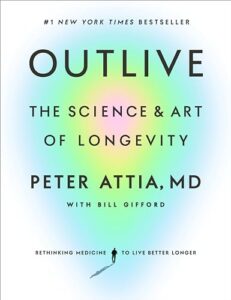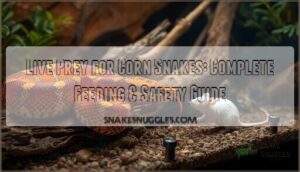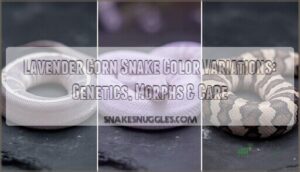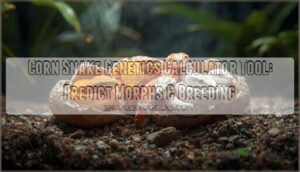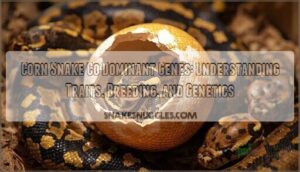This site is supported by our readers. We may earn a commission, at no cost to you, if you purchase through links.
Most corn snakes in captivity live 15-20 years, yet veterinary records show some individuals thriving past 30—a difference that comes down to five controllable care factors. The gap between average and superior longevity isn’t luck or expensive equipment; it’s consistent attention to temperature gradients, prey sizing, humidity control, stress reduction, and early disease detection.
Small missteps in these areas compound over time, gradually shortening your snake’s healthy years through preventable conditions like respiratory infections, metabolic bone disease, or chronic stress.
Extending your corn snake’s lifespan requires understanding how these factors interact and implementing evidence-based husbandry practices that support long-term health rather than just survival.
Table Of Contents
Key Takeaways
- Corn snakes living 30+ years instead of the typical 15-20 years aren’t lucky—they benefit from consistent attention to five controllable factors: temperature gradients, appropriate prey sizing, humidity control, stress reduction through proper handling, and early disease detection through regular veterinary monitoring.
- Your enclosure setup determines whether your snake thrives or merely survives, requiring a thermal gradient from 90°F basking down to 75-82°F cool zones, 65-75% humidity, low-output UVB lighting for metabolic health, and environmental enrichment that studies show adds 2-4 years to lifespan by reducing stress markers up to 30%.
- Diet precision matters more than you might think—prey should match your snake’s mid-body diameter at roughly 10% of body weight, fed every 5-7 days for hatchlings and every 14-21 days for adults, with calcium supplementation 1-2 times weekly to prevent metabolic bone disease that affects improperly fed snakes.
- Preventable conditions like respiratory infections, parasitic infestations, and incomplete sheds stem from small but compounding husbandry mistakes—maintaining stable temperatures, replacing water daily, performing weekly enclosure sanitation, and scheduling annual veterinary exams catch problems before they shorten your snake’s healthy years.
Key Factors Affecting Corn Snake Lifespan
Your corn snake’s lifespan isn’t just a matter of luck—it’s shaped by several controllable factors that work together to keep your snake healthy for years. From the genetic foundation provided by responsible breeders to the daily care you provide, each element plays a measurable role in longevity.
Let’s look at the five key factors that can help your corn snake thrive well into its second decade.
Genetics and Responsible Breeding
While you can’t rewrite your corn snake’s DNA, understanding genetic factors helps you make informed choices. Responsible breeding practices prioritize genetic diversity and morph health, reducing inbreeding risks that shorten lifespan. Here’s what matters:
- Choose breeders who track lineage and avoid repeated inbreeding
- Understand that some morphs carry genetic predispositions affecting longevity
- Recognize lifespan heritability—some lines naturally live longer
- Support breeding ethics that prioritize health over appearance alone
Genetic quality truly influences how long your snake thrives. For example, the amelanism condition is well-documented in corn snakes.
Diet and Nutrition Essentials
Diet and nutrition directly shape your corn snake’s health over decades. Prey selection hinges on appropriate prey size—no more than 1.5 times body width for juveniles, matching the snake’s widest point as adults. Corn snakes are carnivorous and require a meat-based diet.
Feeding schedules vary: hatchlings eat every 5-7 days, adults every 14-21 days. Nutritional supplements like calcium aren’t usually needed with whole prey diets.
Assure continuous water access and monitor weight management to prevent obesity or malnutrition.
Environmental Conditions and Enclosure Setup
Your enclosure setup determines whether your corn snake thrives or just survives. Proper environmental conditions mean achieving a thermal gradient from 90°F basking down to 75-82°F cool zones, maintaining humidity levels between 65-75%, and ensuring complete air exchange every 1-2 hours.
Consider these priorities:
- Secure 40-gallon minimum enclosure with locked mesh lid
- UVB lighting at UVI 2.0-3.0 for bone health
- Multiple hiding spots and habitat enrichment elements
Handling and Stress Management
While your habitat may be ideal, improper handling undoes even the best environmental setups. Gentle handling techniques—supporting your snake’s entire body, limiting sessions to 10-20 minutes, and recognizing stress indicators like rapid tongue flicking or coiling—prevent long-term effects such as immune suppression and feeding refusal.
Regular, patient interaction over 4-6 weeks reduces defensive responses by over 30%, directly supporting stress reduction and longevity.
Regular Health Monitoring
Even with perfect husbandry, preventative health checks remain your best defense against hidden illness. Early diagnosis through weight monitoring and fecal screening directly impacts lifespan, catching respiratory infections, internal parasites, and metabolic disorders before they compromise longevity.
Schedule annual veterinary care for adults, with new or juvenile snakes examined within weeks of arrival for parasite detection and baseline body condition assessment.
Optimizing Habitat for Longevity
Your corn snake’s enclosure isn’t just a home—it’s the foundation for a long, healthy life. Getting the habitat right means paying attention to everything from cage size and temperature to lighting and enrichment.
Let’s walk through the essential elements that’ll help your snake thrive for years to come.
Ideal Enclosure Size and Security
Your corn snake deserves a space that fosters both security and wellness. Adult corn snakes require a minimum terrarium of 48″L x 24″W x 24″H, allowing full body extension—the absolute baseline for proper enclosure setup.
Front-opening glass terrariums with mesh tops, secured with lid clamps and weather stripping, prevent escapes through 3–5 mm gaps. Sizing trends now favor 55–75 gallon enclosures, prioritizing behavioral enrichment with ample hideouts for stress reduction.
Temperature and Humidity Control
Beyond secure walls, maintaining stable temperatures and proper humidity control directly shapes your corn snake’s health. You’ll need a temperature gradient with warm zones at 85–90°F and cool areas around 75°F—this range facilitates thermoregulation behavior and digestion.
Keep humidity between 40–60%, rising to 60–70% during shedding to prevent shedding issues and respiratory health complications, using digital monitoring for accuracy.
Lighting and UVB Requirements
While corn snakes don’t strictly require UVB, providing low-output UVB benefits metabolic health through vitamin D3 synthesis, supporting calcium absorption and reducing metabolic bone disease risk.
Use a 12-hour photoperiod to mirror natural environmental conditions, positioning bulbs 4–6 inches above basking zones for safe placement. Replace bulbs every six months as UVB output declines.
Full-spectrum lighting enhances environmental enrichment while supporting proper circadian rhythms.
Cleanliness and Ventilation
A clean environment acts as your first line of defense against respiratory infections and parasitic infestations that cut short many corn snakes’ lives. Weekly enclosure sanitation with a 3% bleach solution, left for ten minutes, dramatically lowers bacteria levels, while proper airflow management prevents the stagnant conditions that foster fungal pathogens.
- Spot-clean daily to remove waste and maintain substrate hygiene
- Replace water bowls every other day for infection control
- Provide adequate ventilation through strategically placed vents for humidity balance
Environmental Enrichment and Hiding Spots
Think of enrichment as mental exercise that extends life—studies show a 24% increase in brain volume when corn snakes access climbing structures and diverse hides.
You’ll want at least two hiding spots positioned in both warm and cool zones, reducing cortisol markers by 30% while supporting natural exploration patterns.
This environmental enrichment directly correlates with 2-4 additional years of lifespan, transforming mere survival into genuine snake wellbeing.
Environmental enrichment adds 2-4 years to your corn snake’s life, turning basic survival into genuine wellbeing
Diet and Nutrition Tips for Long Life
Your corn snake’s diet directly impacts how long and how well it lives, making nutritional decisions some of the most important choices you’ll make as an owner. Getting the basics right—from prey size to feeding schedules—prevents common health problems and promotes strong immune function throughout your snake’s life.
Let’s walk through the essential nutrition strategies that keep corn snakes thriving for decades.
Appropriate Prey Size and Type
Your corn snake’s longevity depends heavily on selecting appropriately sized prekilled prey. Rodents matching your snake’s mid-body diameter guarantee safe digestion.
Meal weight should hit roughly 10% of body weight, with adult mice (25-30 grams) suited for mature snakes and pinky mice (2-3 grams) for hatchlings.
Varied diets incorporating mice, rats, and quail prevent nutritional deficiencies while maintaining rodent nutrition’s protein-rich benefits. However, oversized prey risks regurgitation and feeding risks like digestive blockages.
Feeding Frequency by Age
Once you’ve nailed prey size, feeding frequency becomes your next important consideration. Hatchling diets require prekilled rodents every 5-7 days to fuel rapid growth, while juvenile snakes move to 7-10 day intervals as metabolism slows.
Subadult adjustments extend this to 10-12 days, and adults thrive on 14-21 day feeding schedules. Senior needs may require 10-14 day intervals, preventing adult obesity while maintaining a healthy weight throughout your snake’s lifespan.
Nutritional Supplements (Calcium, Vitamin D3)
While timing matters, your corn snake’s ideal diet needs nutritional supplements to prevent metabolic bone disease. Calcium ratios should hit 2:1 calcium-to-phosphorus, yet frozen pinkie mice fall short at 0.79:1.
Dust prey with calcium powder 1-2 times weekly, and guarantee D3 synthesis through UVB exposure or dietary vitamins.
These minerals drive supplement delivery that measurably improves health outcomes, reducing skeletal abnormalities by 40% in supplemented snakes.
Providing Fresh Water
Beyond supplements, your corn snake requires fresh, clean water replaced daily to support hydration and shedding health. Water bowl hygiene directly impacts longevity—scrub bowls every few days to prevent bacterial biofilm.
Choose shallow dishes allowing full-body soaking, which aids skin hydration and reduces dehydration symptoms like lethargy or incomplete sheds. Spring or filtered water eliminates chlorine risks, while humidity levels between 65-75% complement proper water source safety and hydration schedules.
Preventing Obesity and Malnutrition
Since both ends of the nutritional spectrum threaten longevity, you’ll need careful oversight of your corn snake’s body condition and feeding consistency. Portion control prevents obesity by keeping prey diameter below 1.5 times your snake’s body width, while feeding frequency—every 7-14 days for adults—maintains nutritional balance without power feeding risks.
Key indicators requiring immediate adjustment include:
- Bulging body shape signaling obesity from excessive portions
- Visible spine or ribs indicating malnutrition from inadequate feeding schedule
- Exercise enrichment through climbing structures preventing sedentary weight gain
- Calcium-to-phosphorus imbalances causing metabolic bone disease in juveniles
Preventing Common Health Issues
Keeping your corn snake healthy means staying ahead of problems before they start. Most health issues, from respiratory infections to stubborn sheds, are preventable with the right care and a watchful eye.
Let’s walk through the most common concerns you’ll want to monitor and how to recognize trouble early.
Respiratory Infection Prevention
Did you know a single night of unstable temperature can set the stage for respiratory infections in corn snakes? You’ll want to keep Humidity Control between 40–60%, maintain Temperature Stability, and guarantee Ventilation Quality.
Watch for wheezing or bubbling at the nostrils—Early Detection matters. Proactive Hygiene and disease prevention, like routine cleaning and vet visits, are your best defense.
Managing Shedding and Skin Health
When your corn snake starts a shed, pay close attention to Shedding Frequency and Humidity Levels—these can make or break snake health. Retained eyecaps and scale discoloration often signal shedding problems. Nutritional Impact matters, too; calcium and vitamin D3 help prevent shedding difficulties. If you spot persistent scale issues, don’t hesitate—Veterinary Intervention is your best move.
- Monitor humidity (40–60%)
- Offer rough surfaces for shedding
- Supplement calcium and vitamin D3
- Remove shed skin promptly
Parasite Detection and Control
Did you know up to 27% of snakes in North Carolina carry helminth parasites? Your best defense is a blend of Fecal Monitoring, Quarantine Protocols, and Preventative Hygiene. Internal and external parasites—ticks, worms, protozoa—can cause serious harm, and some pose Zoonotic Risks. Rapid detection and proven Treatment Efficacy keep parasitic infestations from unraveling your snake’s health.
| Detection Method | Control Strategy |
|---|---|
| PCR & Wet Mount | Quarantine Protocols |
| Cloacal Swabs | Preventative Hygiene |
| Fecal Monitoring | Treatment Efficacy |
| Sample Processing | Zoonotic Risks Awareness |
Recognizing Signs of Illness and Aging
When you spot Appetite Changes or dull patches on your snake’s skin, think of them as your “canaries in the coal mine” for common health issues.
Four signs that should catch your eye:
- Persistent scale issues and faded coloration
- Digestive symptoms like diarrhea or vomiting
- Neuro changes—wobbliness or confusion
- New hiding or defensive behavioral changes
Stay alert to aging signs.
Importance of Regular Veterinary Visits
Ever wonder how much can hinge on a single appointment? Regular vet visits with a qualified reptile vet offer more than early disease detection—they lay the groundwork for health baseline documentation, spot nutrition gaps, and steer clear of preventable morbidity.
Every checkup sharpens your skills in zoonotic disease prevention and keeps you a step ahead in supporting your corn snake’s longevity.
Top Products to Extend Corn Snake Lifespan
Choosing the right products can make a real difference in your corn snake’s health and longevity. Some essentials work behind the scenes to create a safer, more comfortable habitat.
Here’s a closer look at the top picks that help support a long, healthy life.
1. Reptispa LED UVB Reptile Lamp
You’ll find the Reptispa LED UVB Reptile Lamp combines practical energy efficiency with measurable longevity effects for your snake. Its UVB output, ranging from 30 to 50 microwatts per square centimeter at twelve inches, promotes vitamin D3 synthesis and calcium metabolism, both essential environmental factors in bone health.
The lamp lifespan extends up to 2,000 hours, though you should replace it every six to twelve months to maintain effective UVB radiation. Position it over mesh rather than glass to help guarantee safe, consistent lighting—an essential component of environmental enrichment and overall habitat quality.
Best For: Corn snake owners looking for an energy-efficient UVB lamp that supports vitamin D3 synthesis and bone health without adding significant heat to the enclosure.
- Delivers measurable UVB output (30-50μW/cm² at 12″) that helps corn snakes synthesize vitamin D3 and absorb calcium, reducing the risk of metabolic bone disease and supporting longer lifespans.
- Energy-efficient LED technology uses less power than traditional fluorescent bulbs while lasting up to 2,000 hours, making it a cost-effective choice for long-term use.
- Compact aluminum housing with heat dissipation channels keeps the lamp cool, so you can provide essential UVB without overheating your snake’s habitat.
- Produces no noticeable heat, so you’ll need to pair it with a separate heat source like a ceramic heater or heat pad to maintain proper temperatures for your corn snake.
- Requires replacement every 6-12 months despite a 2,000-hour lifespan, as UVB output degrades over time and loses effectiveness for vitamin D3 synthesis.
- Must be installed over mesh or open-air sections since UVB can’t penetrate glass or plastic, which may limit placement options in some enclosure setups.
2. Lifespan Equine Herbal Anti Inflammatory
While illumination aids snake longevity, herbal anti-inflammatory supplements—marketed for equine joint health—don’t apply to reptile care. Boswellia and turmeric, though studied for supplement efficacy in horses, aren’t appropriate or tested for corn snakes.
Market trends show broad dosage guidelines for mammals, but environmental conditions—proper temperature, humidity, and nutrition—remain the proven factors affecting corn snake lifespan.
You won’t extend your snake’s years with equine products; instead, focus on species-specific veterinary recommendations that directly address reptile physiology and health needs.
Best For: Horse owners looking for a natural supplement to manage joint inflammation, stiffness, or mobility issues in their horses without relying solely on pharmaceutical options.
- Contains research-backed ingredients like Boswellia and turmeric that have been shown to reduce inflammatory markers and improve antioxidant capacity in horses within 10 days.
- Targets multiple inflammation pathways with a combination of herbal extracts and vitamin C, supporting joint, tendon, and ligament health.
- Well-tolerated with minimal reported adverse effects in horses, making it a safer alternative or complement to conventional treatments.
- High price point (typically $45-$80) with no money-back guarantee, which can be a risk if your horse doesn’t respond well to the supplement.
- Some horses reject it due to taste or smell issues, potentially wasting the product if your horse won’t consume it.
- Limited long-term safety data and potential for contamination or interactions with other medications your horse may be taking.
3. Lifespan Telomere Effect How Not Die
This three-book collection explores human aging science—telomere length, cellular aging, and oxidative stress—but doesn’t translate to corn snake care.
Research shows telomeres in snakes range from 16 to 25 kilobases and decrease with age, yet longer telomeres don’t reliably predict increased survival or longevity in reptiles. DNA repair mechanisms and lower oxidative stress contribute more to lifespan than telomere manipulation.
You’ll gain better results focusing on proven factors: genetics from responsible breeders, suitable environmental conditions, and species-specific health monitoring rather than applying mammalian longevity concepts to reptile husbandry.
Best For: Readers interested in human longevity science who want evidence-based guidance on aging, cellular health, and nutrition—not applicable to reptile care or corn snake lifespan extension.
- Covers scientifically-backed methods for understanding human cellular aging, telomere health, and disease prevention through nutrition.
- Written by respected authors in health and wellness fields, offering accessible explanations of complex biological concepts.
- Provides practical tools for readers looking to improve their own healthspan and make informed lifestyle choices.
- Product inconsistencies reported—some customers received paperback copies instead of advertised hardcover editions or encountered missing books.
- Research and advice focus exclusively on human biology and don’t translate to reptile husbandry or corn snake care practices.
- Font size in some copies may be smaller than expected, potentially affecting readability for certain users.
4. The Life Span Human Development
This human development textbook examines growth patterns and aging rates across species, including reptiles with captive longevity exceeding wild populations. You’ll find concepts like evolutionary pressures shaping senescence and environmental stressors affecting lifespan, but applying these to your corn snake requires translation.
Factors affecting corn snake lifespan—genetics, environmental conditions, veterinary care—align with reptile-specific data showing 80% of species age slower than mammals under proper care. Instead of comparative psychology, focus on evidence-based husbandry practices that directly extend your snake’s years.
Best For: Students and professionals in counseling, education, social work, or psychology who need a comprehensive textbook covering human development across the entire lifespan with current research and practical applications.
- Covers the full lifespan with updated research, new data on stress and technology’s impact on development, and real-world vignettes that make complex concepts easier to understand.
- Written specifically for helping professionals, offering best practices and frameworks you can actually use in fields like counseling, teaching, or social work.
- Takes a holistic approach by examining development within family, social, and cultural contexts rather than just looking at individuals in isolation.
- Expensive at around $199, which is a significant investment compared to other textbooks or digital resources.
- Heavy and bulky at 3.58 pounds with over 800 pages, making it less portable for students who need to carry it around campus.
- Some instructors may not assign it despite the cost, leaving students with an expensive book they don’t actually use in class.
5. Outlive The Science Of Longevity
Why would a human longevity book matter for your corn snake’s care? Because its Medicine 3.0 framework—emphasizing risk assessment, early intervention, and proactive dietary guidelines over reactive treatment—mirrors ideal reptile husbandry.
Longevity scores for humans translate to monitoring your snake’s environmental conditions, veterinary care schedules, and nutrition before health issues emerge.
Studies show 65% reductions in chronic disease risk through early lifestyle adjustments; applying this evidence-based mindset to your corn snake’s habitat and diet extends lifespan by preventing problems rather than treating them.
Best For: People who want to take control of their long-term health with a science-backed, proactive approach to preventing chronic diseases like heart disease, cancer, and Alzheimer’s.
- Combines cutting-edge longevity research with practical strategies for exercise, nutrition, sleep, and emotional health that can extend your healthspan by years.
- Offers personalized risk assessments and early screening recommendations that could reduce your chronic disease risk by up to 65% before symptoms even appear.
- Provides detailed guidance on fitness and nutrition—like hitting 150-300 minutes of weekly exercise and optimizing protein intake—that’s shown to lower mortality rates and improve quality of life.
- The scientific depth can get heavy for readers without a medical background, making some sections feel like a textbook rather than a casual read.
- Exercise recommendations might feel overwhelming or unrealistic if you’re not already active or have physical limitations.
- Insurance may not cover the early preventative tests and screenings the book recommends, potentially creating financial barriers to following the full program.
6. Lifespan and 12 Rules Collection
You might wonder what a two-book collection on aging and personal order brings to extending corn snake lifespan. Book insights on longevity rules—such as consistent routines, environmental stability, and early risk detection—apply directly to factors affecting corn snake lifespan.
Though order issues and relevance concerns appear in reviews, the healthspan inspiration these texts provide translates to proactive husbandry. Factors influencing corn snake longevity include predictable feeding schedules, stable enclosures, and routine wellness exams that prevent problems before they shorten your snake’s years.
Best For: Readers who want to explore the science of aging and personal development principles that can inspire better care routines for long-lived pets like corn snakes.
- Combines cutting-edge longevity research with practical life principles that translate well to creating stable, health-focused routines for pet care.
- Covers topics like environmental consistency and early problem detection that mirror best practices for extending corn snake lifespan through proper husbandry.
- Offers inspiration to take a proactive approach to health and wellness, which can motivate more attentive care for animals that thrive on routine and stability.
- Some readers report the content feels either too technical or too surface-level, which may limit its practical usefulness depending on your background.
- Multiple reviews mention receiving incomplete or incorrect orders, including missing books or wrong editions like paperback instead of hardback.
- Not every book in the set will be relevant to all readers, especially those primarily interested in reptile care rather than human health or self-help topics.
7. Life Span Human Development Textbook
This textbook might seem like an odd pick for extending corn snake lifespan, yet understanding developmental domains, lifespan principles, and nature/nurture interactions reveals valuable parallels.
Research methods described—longitudinal studies tracking changes across decades, standardized metrics, and developmental stages—mirror proper corn snake care approaches: consistent environmental conditions, methodical diet and nutrition tracking, and regular veterinary care.
While you won’t apply human psychology directly, the framework for documenting growth, evaluating health benchmarks, and recognizing age-related changes strengthens your husbandry strategy for best longevity.
Best For: Psychology, counseling, and human development students who need a clear, research-backed textbook covering physical, cognitive, and psychosocial development from conception through late adulthood.
- Covers all life stages with a strong focus on biological and sociocultural influences, backed by longitudinal and cross-sectional research methods.
- Written in straightforward language that makes complex developmental theories and empirical findings accessible to students.
- Includes MindTap digital resources with quizzes, flashcards, and case studies for flexible, interactive learning anywhere.
- At $83.37, the price may stretch tight student budgets, though renting could be a more affordable option.
- The 10th edition may eventually become outdated as newer research and editions are published.
- Used book quality can be inconsistent, so you’ll want to check seller ratings carefully before purchasing.
8. Development Through the Lifespan Book
Laura Berk’s 864-page volume examines developmental stages through rigorous research integration, offering pedagogical tools that translate surprisingly well to reptile husbandry. Its lifespan application framework—tracking biological, psychological, and environmental conditions and lifespan trajectories—mirrors the factors affecting corn snake lifespan you’ll document over decades.
Edition history since the late 1990s reflects evolving evidence standards, reinforcing genetic influences on lifespan and systematic environmental monitoring. While human-focused, its methodology strengthens your approach to tips for extending corn snake lifespan through disciplined, long-term care protocols.
Best For: Students and professionals in psychology, education, social work, or healthcare who need a comprehensive, research-backed guide to human development from conception through death.
- Integrates current research with practical applications through tables, critical thinking questions, and real-world examples that make dense material easier to absorb and apply.
- Strong multicultural and cross-cultural focus provides diverse perspectives on development across different populations and contexts.
- Organized clearly by developmental periods and domains (physical, cognitive, psychosocial), making it easy to find specific information on any life stage.
- The digital version suffers from poor formatting issues that make reading difficult, especially for students who prefer e-books.
- At 864 pages, the book is dense and information-heavy, which can feel overwhelming and challenging to work through in a single semester.
- Used copies may arrive with previous owner markings or wear and tear, and some reviews mention inconsistent book quality or functionality.
Frequently Asked Questions (FAQs)
Can corn snakes recognize their owners over time?
They can’t see your face, yet they know you’re there. Through scent recognition and environmental enrichment, corn snakes demonstrate learning capacity, identifying familiar handlers by odor cues and behavioral changes, reducing handling stress over time.
Do corn snakes need companionship or prefer solitude?
Corn snakes strongly prefer solitary behavior, thriving best when housed individually. Cohousing risks include stress indicators like inappetence, increased disease transmission, and competition.
Husbandry guidelines universally recommend single housing for stress reduction and best well-being.
How does brumation affect corn snake longevity?
Many keepers wonder if seasonal dormancy improves longevity. Brumation benefits include metabolic slowdown and breeding success, though infection risks exist.
Research shows minimal lifespan extension differences, making brumation optional unless you’re breeding your corn snake.
What substrates are safest for corn snakes?
You’ll want aspen bedding, coconut fiber, or soil-based mixtures for your corn snake’s enclosure setup.
These substrate options support burrowing behavior, regulate humidity, and minimize respiratory health risks while preventing infection and substrate impaction risk through proper maintenance.
Should I handle my corn snake during shedding?
Is handling tempting when your snake’s eyes cloud? During shedding, avoid contact—stress hormones spike, defensive bites increase, and scale damage risks rise.
Ecdysis behavior demands hydration importance and stress reduction for best snake health.
Conclusion
Think of your corn snake’s health as a garden that either flourishes or withers based on daily tending. Extending your corn snake’s lifespan isn’t about heroic interventions—it’s the cumulative effect of consistent temperature monitoring, appropriate feeding schedules, and vigilant observation.
Those veterinary records showing 30-year-old snakes don’t reflect luck; they document owners who treated preventive care as routine maintenance, not optional luxury. Your snake’s longevity begins with decisions you’ll make tomorrow morning.
- https://talis-us.com/blogs/news/how-long-do-corn-snakes-live
- https://en.wikipedia.org/wiki/Corn_snake
- https://reptifiles.com/corn-snake-care-guide/corn-snake-temperatures-humidity/
- https://www.thebiodude.com/blogs/snake-caresheets/care-guidelines-for-corn-snakes
- https://www.youtube.com/watch?v=8FS9VhPSM9s





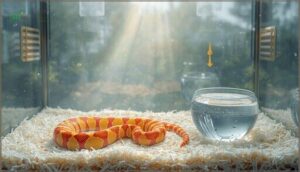
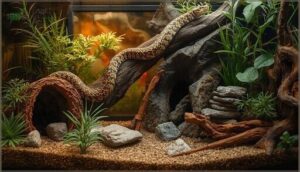

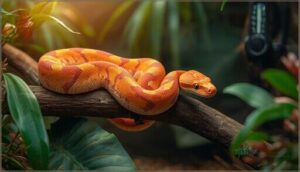
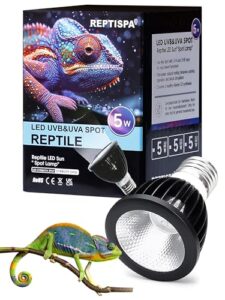

![Lifespan [Hardcover], The Telomere Effect, 9123906057](https://snakesnuggles.com/wp-content/uploads/2025/11/lifespan-hardcover-the-telomere-effect-9123906057-300x300.jpg)

